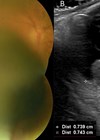Uveal melanoma (UM) is the most common malignant tumour arising within the eye and is a severe threat for both sight and life, due to a high risk of metastasis. There are no animal models of UM, but the Tg(Grm1) in which the glutamate receptor 1 (Grm1) transgene is under the control of the melanocyte specific dopachrome tautomerase (Dct) promoter, was developed as a model for skin melanoma. As Dct is expressed in all melanocytes the authors assessed the Tg (Grm1) mouse for signs of ocular melanoma. The results showed choroidal thickening, and uveal melanocyte neoplasia using melanocytic markers S100B and MelanA. Importantly, analysis of human UM samples showed expression of Grm1, suggesting that glutamate signalling is involved in human disease. These results identify the Tg(Grm1) mouse as a new model for uveal melanoma that should allow for further dissection of the mechanisms involved in imitation and a therapeutic model for drug testing.




